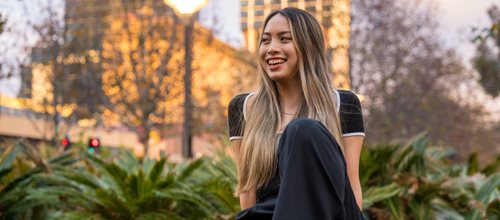Achievements and Announcements
ACHIEVEMENTS
- UniSA students recognised at the annual Playford Trust Awards
- Journalism students participate in national election radio broadcast
- Research centre awarded for innovative work in nurse-led skin cancer detection
- University secures EQUIS accreditation
- Creative workshops to aid healing
- Next gen architects break ground at the Venice Biennale
- Branching out: PhD student selected for prestigious NASA internship
- Prof Byron Sharp honoured with prestigious Lifetime Achievement Award
- PhD student makes a big splash with his research
- King’s Birthday Honours for UniSA community
- Other recent award winners and grant recipients
ANNOUNCEMENTS
APPOINTMENTS
ACHIEVEMENTS
UniSA students recognised at the annual Playford Trust Awards
Four UniSA students have been awarded scholarships and one a commendation at this year’s Playford Trust Awards.
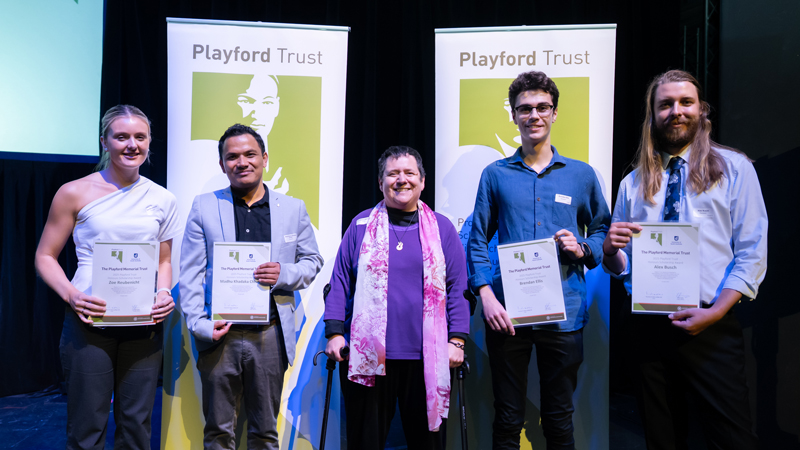 UniSA Playford Trust Honours recipients Zoe Reubenicht, Madhu Khadaka Chhetri, Brendan Ellis, and Alex Busch with Executive Dean of UniSA STEM Professor Jacqui Rummage.
UniSA Playford Trust Honours recipients Zoe Reubenicht, Madhu Khadaka Chhetri, Brendan Ellis, and Alex Busch with Executive Dean of UniSA STEM Professor Jacqui Rummage. Alex Busch, Brendan Ellis, Madhu Khadaka Chhetri and Zoe Reubenicht all received Playford Trust Honours Scholarships while Kaitlyn Ford was recognised with a Playford Trust Commendation Award.
Each year, the trust awards 12 scholarships worth $7000 to South Australians intending to study honours or a fourth year of an undergraduate degree in STEM-related areas. Four of these scholarships are allocated to each of the state’s three universities.
Environmental science student Alex Busch is undertaking an honours research project, which looks at how constraints introduced by improperly executed amelioration practices can be remediated to restore agricultural land and soil to a productive state.
Busch started the project during his internship with the South Australian Grains Industry Trust and EPAG Research on the Eyre Peninsula last year.
During an internship with engineering consultancy firm Wallbridge Gilbert Aztec, civil and structural engineering student Brendan Ellis worked on projects including the Adelaide Airport Northern Terminal Expansion and the Crown & Anchor Hotel redevelopment.
Now, as he enters his final year of his degree, Ellis’s research will focus on the effect of ‘creep’ – or deformation over time due to the application of permanent loads – on laminated timber, a popular material in construction.
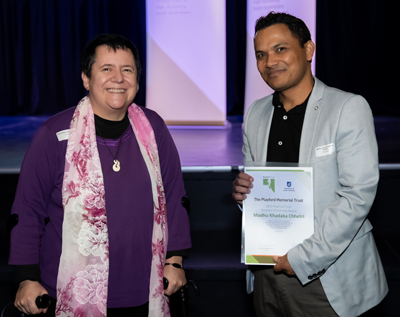 Madhu Khadaka Chhetri with Executive Dean of UniSA STEM Professor Jacqui Rummage.
Madhu Khadaka Chhetri with Executive Dean of UniSA STEM Professor Jacqui Rummage. Madhu Khadaka Chhetri is a medical radiation science student with a focus on medical imaging and is currently undertaking his honours project exploring surface imaging as a non-ionising alternative to bladder filling assessment during prostate cancer radiotherapy.
Madhu hopes to demonstrate that the treatment of prostate cancer can be improved by the reducing the radiation dose currently required for CT imaging which will have direct clinical impact.
Mechanical engineering student Zoe Reubenicht completed an internship with the Australian Submarine Corporation (ASC) over the summer break and has selected ASC as her industry partner for her thermodynamics honours project.
Reubenicht will investigate how the use of ‘dimpled tubes’ can make the transfer of heat in submarines more efficient.
Kaitlyn Ford, another engineering student with an interest in civil and construction management, received a commendation award.
In total, 51 students were recognised at this year’s Playford Trust awards, a record for the annual event. The trust awarded 45 scholarships and, for the first time, six additional commendations.
Journalism students participate in national election radio broadcast
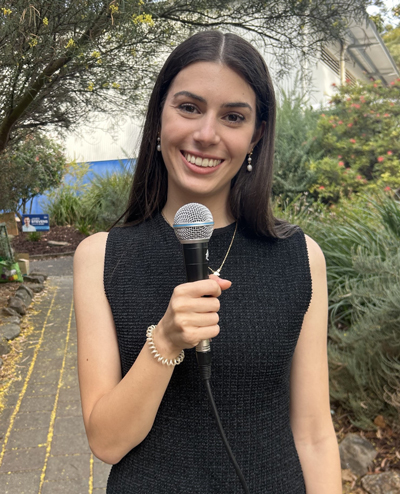 Leia Vlahos getting ready to cover Sturt for the broadcast.
Leia Vlahos getting ready to cover Sturt for the broadcast.UniSA journalism students took part in a live national radio broadcast of the federal election in May.
Students Leia Vlahos, Mia Handley and Robert Hicks are members of On The Record, UniSA’s online student journalism platform, and were among 70 other budding journalists from across the country who participated in the broadcast.
The Junction, an online collaborative publication that showcases student journalism from Australia, New Zealand and the Pacific, organised the broadcast and reached out to the On The Record team for assistance in covering the South Australian results.
While UniSA and On The Record had contributed articles to The Junction’s federal election coverage in the past, this year marked the first time the team had been part of the live broadcast.
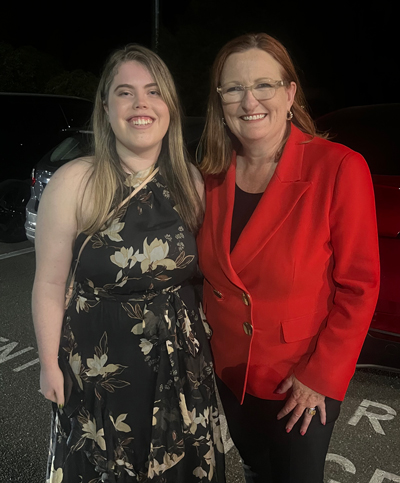 Mia Handley and Labor candidate Louise Miller-Frost.
Mia Handley and Labor candidate Louise Miller-Frost.Vlahos and Handley were assigned an electorate each – Sturt and Boothby respectively – while Hicks covered the state more generally.
In the lead up to the event, the students researched their electorates and the candidates, attended training seminars, prepared notes, and organised access to the Labor and Liberal after-parties.
On the day itself, Vlahos had her hands full with a variety of tasks.
“In the morning, I conducted interviews with the Labor and Greens candidates,” she says. “The afternoon was a rush to edit and submit the audio for these interviews.
“Later, my biggest responsibility was to keep track of the updates for Sturt and report back to the broadcasting team.
“They called me at eight o’clock and told me to prepare to go live in an hour. During that time, I checked the AEC results, listened to The Junction’s broadcast, and attended the two major parties’ events.
“I was live on air for five minutes, answering the hosts’ questions about Sturt over the phone. We spoke about the past margin, the current swing, and the difference between the two major candidates.”
Over in Boothby, Handley had a similar experience.
“I was a reporter so I had to go to the election parties and report over the phone on how the count was going," she says.
“The broadcasting team was supposed to call me twice, but the election was called a lot earlier than expected so the plans went out the window. I went live once, which was after Boothby was conceded.
“For the rest of the night, I got social media content at the Labor election party, including vox pops and an interview with the Labor candidate, Louise Miller-Frost.”
UniSA journalism lecturer and course coordinator Charlotte Chalklen says that the experience was invaluable for her students.
“They got to practice what live coverage is all about,” Chalklen says. “Getting out there and reporting on events as they unfold.
“They got experience working on their feet, interviewing politicians, supporters, and people at the polls on the day, and going to air immediately.
“This is something that broadcast journalists do all the time, but it’s not always easy to replicate in the tutorial room.
“It was also really valuable to have a coordinated, national activity like this where the student journalists here in SA were part of a larger network, giving them a taste of what it’s like to be part of a national media network.”
Read On The Record online and follow the team on Facebook and Instagram.
Research centre and professor awarded for innovative work in nurse-led skin cancer detection
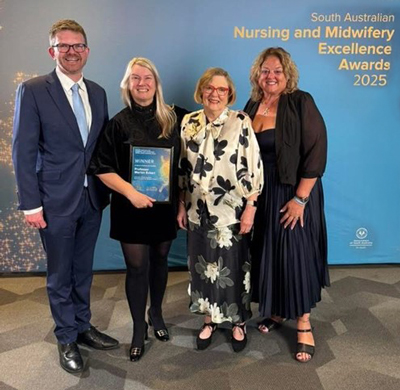 Professor Marion Eckert celebrating at the SA Nursing and Midwifery Excellence Awards. L-R: Chris Picton MP, Professor Marion Eckert, Rosemary Bryant AO, and Nat Cook MP.
Professor Marion Eckert celebrating at the SA Nursing and Midwifery Excellence Awards. L-R: Chris Picton MP, Professor Marion Eckert, Rosemary Bryant AO, and Nat Cook MP.UniSA Professor Marion Eckert and the research centre she leads have both received awards for their innovative work in nurse-led skin cancer detection.
Professor Eckert, Director of the Rosemary Bryant AO Research Centre (RBRC), received the Excellence in Research and Innovation Award at the 2025 SA Health Nursing and Midwifery Excellence Awards, and accepted the Outstanding Organisation Award on behalf of the RBRC itself at the 2025 HESTA Australian Nursing and Midwifery Awards.
Both awards relate to the innovative work by Professor Eckert and the RBRC, which involves educating nurses to perform skin checks using dermatoscopes and AI-technology and training them at pop-up clinics in regional and rural Australia.
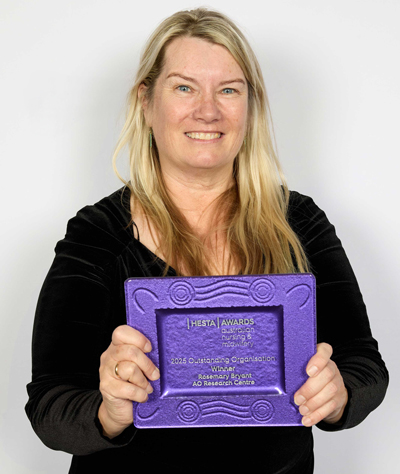 Professor Marion Eckert receiving the HESTA Australian Nursing and Midwifery Outstanding Organisation Award on behalf of the RBRC
Professor Marion Eckert receiving the HESTA Australian Nursing and Midwifery Outstanding Organisation Award on behalf of the RBRCOriginally named ‘Project Check Mate’, this work officially launched in 2023 with a world first pop-up clinic in Victor Harbor. Nurses working at the clinic were in the middle of a nine-week training program where they were learning to use AI-tools to triage and conditionally diagnose suspicious lesions.
Now, the project operates as the ‘600 Nurses Project’ which aims to educate 600 nurses nationally.
Since the project’s inception, pop-up clinics have been run at 13 locations across regional and rural South Australia, including at BHP-operated mines and state prisons. Fifty one nurses have been trained, 1216 people have been screened, and hundreds of suspicious lesions have been identified, including 96 that have been suspected as melanoma.
Following the success of the clinics, Professor Eckert and the RBRC will deliver a Professional Certificate in Clinical Dermoscopy at UniSA commencing in July. The 13-week course is designed for nurses who will be trained in skin checks, dermoscopy, imaging and early detection of skin cancer, expanding their scope of practice.
The project began when Professor Eckert and the team at the RBRC decided to tackle the service gap in the provision of skin checks for people living in regional and rural Australia. People living in these parts of the country have a 15-31% higher incidence of skin cancer than in metropolitan areas, and experience challenges in accessing preventative healthcare.
Nurses are the largest distributed healthcare professionals in regional areas and are therefore best placed to work collaboratively with general practitioners and dermatologists to provide skin checks, thereby closing the service gap.
University secures EQUIS accreditation
UniSA’s business school has once again earned global endorsement for excellence under the European Foundation for Management Development’s (EFMD) top tier accreditation program, the European Quality Improvement System (EQUIS).
UniSA Business was successful in securing a five-year accreditation under the EFDM’s regular program of business education equality assessment, which is the highest-level accolade under the EQUIS system.
Only 1% of business schools worldwide have earned the accreditation, and this success reflects UniSA’s position in the top 10 business schools in Australia.
Executive Dean UniSA Business, Professor Andrew Beer, says the accreditation marks a significant milestone in its ongoing commitment to academic excellence and impactful research, particularly as UniSA prepares to join forces with the University of Adelaide to become Australia’s future-ready university – Adelaide University.
“Our continuing accreditation is a testament to the dedication and expertise of our staff, students, alumni and partners and as we become Adelaide University in 2026. It will only help us to deliver more globally relevant research and teaching while helping us to continue to engage with industry and communities,” he says.
“This accreditation places the new business school in the best possible position as it emerges and looks to shape the future of research and teaching across South Australia, nationally and globally.”
EQUIS accreditation involves a comprehensive review of business and management schools. Its rigorous peer-review process signals the school’s overall quality, viability and commitment to continuous improvement, the employment outcomes for graduates, as well as the level of engagement with students, employers and academic partners worldwide.
Creative workshops to aid healing
A senior research fellow and UniSA alumnus have been awarded a scholarship to create a series of creative community workshops to help people who have experienced coerced medical intervention.
Dr KJ Hepworth and UniSA alumnus Tabitha Lean have won a 2025 Stratford Scholarship from Mind Australia, an organisation supporting people experiencing mental health and wellbeing concerns to find help, hope and purpose in their lives.
The $10,000 scholarship supports emerging peer leaders to complete a 12-month project that supports the mental health and wellbeing of people in the community.
Dr Hepworth and Lean will use the opportunity to develop a series of creative community workshops to share survival strategies, communal space, abolitionist dreaming, and visual storytelling resources for people who experienced past or present coerced medical intervention.
Coerced medical intervention refers to medical incarceration in locked hospital wards and being subject to government-issued Community Treatment Orders, whereby a medical authority removes a person’s right to consent to their own medical care.
Dr Hepworth says work is urgently needed, because currently South Australia has the highest rate of state sanctioned coerced medical intervention in the world, per capita.
“We know healing happens in community. We also know the most innovative and effective strategies often come from within communities impacted by the most inequitable treatment. This project creates space for creative community connections while also documenting and elevating the innovative healing strategies we know South Australian survivors are already using,” Dr Hepworth says.
The workshops will ask participants ‘what is your story?’ and ‘what do you want other survivors to know?’.
“The project will produce a free resource, titled Surviving Cramond Mad Skills. This will contain stories and strategies by and for South Australian psychiatric survivors,” Dr Hepworth says.
“The resource will centre this communities’ power, resilience, and resourcefulness, mapping pathways to communal care and collective liberation.
“The resource will pool a wealth of survivor wisdom about how to live well inside forced treatment conditions, how to heal and resist, and how to build new futures outside the carceral psychiatric model.”
Next gen architects break ground at the Venice Biennale
Three UniSA architecture students have been selected to have their works showcased at a renowned international global architecture festival in Italy.
The students were selected to exhibit an artefact at the 2025 Venice Biennale in the Australian Pavilion from May until November.
Oshadi Abeygunasekera (Master of Design – Interior Architecture), Lily Pertl (Master of Architecture) and Sabrina Sterk (Master of Architecture) are among 29 students from around Australia selected to have their projects included in the Living Belongings exhibition within the premier cultural event.
The artefacts were created as part of a nationally run elective within architecture programs, HOME: Country as Creative Practice, a culturally rich experience encouraging students to explore the dynamism of Country and the interconnectedness of art and architecture.
Facilitated by Aboriginal academic practitioners, the elective had a significant focus on Aboriginal and Torres Strait Islander knowledges, with students asked to create an artefact responding to the theme ‘Country as Home’ and to reflect their own understanding of what ‘home’ means to them.
This outcome focused on engaging with Country as a source of influence in creative and architectural practice, aiming to deepen students’ understanding of First Nations cultural practices by connecting to ‘place’ and using natural materials.
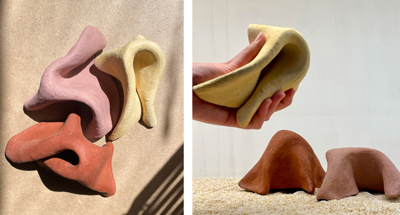
Master of Design – Interior Architecture student Oshadi Abeygunasekera says her idea of home is rooted in the comforting familiarity of childhood memories, growing up in Sri Lanka.
"This artwork expresses my deep connection to home, rooted in the mountainous landscape of Kandy, Sri Lanka, where the hills that inspired its form were a constant presence in my most cherished childhood memories,” she says. “Collecting materials from nature and crafting with them was a treasured part of these experiences, making the creative process central to my understanding of home. Now in Adelaide, the familiar hills brought comfort, and their changing colours at sunset added a new layer, reflected through ochre pigments.”

Master of Architecture student Lily Pertl describes home as “light, warmth, connection, and flame”.
“The curved eucalyptus wooden element grounds and contains the piece, like the home of the flame and the fuel of the fire, it requires balancing and facilitates movement and connection. The expressed grain of the timber, a fingerprint of its life, giving the impression of flame-like patterns across its surface. Cradled amidst the wooden curvature lies the redgum strip veneer vessel, its form and rich materiality represent the warmth, movement and ethereal qualities of flame as it hovers over the containing timber element. Hidden within the vessel lies a treasure, the golden amber resin of the Ironbark tree.”
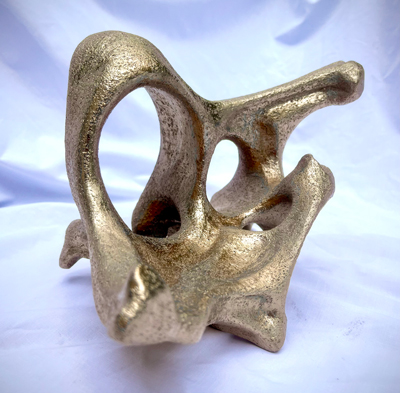
Fellow Master of Architecture student Sabrina Sterk’s sculpture is crafted from white raku clay and reflects themes of identity, memory, connection and the cyclical relationship between humans and nature.
“A Pavillion Within is a sculptural story, celebrating the union between human and earth, energy and matter,” she says. “Embedded within the sculpture's abstracted form lives a narrative about ‘home,’ exploring the connection one has to the environment in which this place is constructed. For ‘home’ transcends mere physical space; it is a deeply emotional and psychological construct tied to identity, belonging, memory, and security.”
Branching out: PhD student selected for prestigious NASA internship
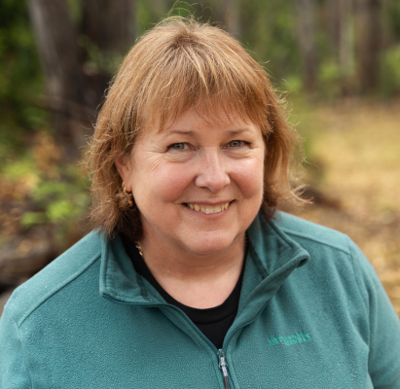 Environmental Science PhD student Donna Fitzgerald will intern at NASA for the US summer.
Environmental Science PhD student Donna Fitzgerald will intern at NASA for the US summer.Donna Fitzgeralds’ passion for environmental science is taking her from the leafy Adelaide Hills to sunny California, securing a competitive 10-week internship at one of the world’s most prestigious space agencies.
The UniSA and SmartSat PhD student will spend the US summer at NASA’s Jet Propulsion Laboratory (JPL), working with satellite imagery to develop methodologies for assessing vegetation health and stress factors contributing to landscape changes.
Working under the mentorship of David Schimel, NASA Senior Research Scientist and Technical Group Supervisor for Carbon and Ecosystems, Fitzgerald will have a once in a lifetime opportunity to expand her knowledge and gain valuable new skills applicable to her research back in Australia.
Her UniSA PhD studies involve using remote sensing technology to quantify dieback of eucalyptus forests in South Australia. She also works part time at SmartSat as a student support officer.
Fitzgerald says the opportunity to intern at JPL will significantly enhance her research skills in developing methods to analyse and understand Australian vegetation using hyperspectral satellite imagery.
“I am thrilled to be selected for the NASA JPL internship. It is an amazing opportunity to further develop my skills as an environmental scientist, using Earth Observation imagery to identify changes in vegetation across the landscape,” she says.
NASA JPL leads the world in robotic space exploration and science, sending spacecraft all through the solar system, deploying rovers such as Perseverance and Curiosity to Mars, managing a slew of Earth Science missions; and providing cameras to the James Webb Space Telescope project.
Beyond the technical and research benefits, the internship will provide Fitzgerald with an opportunity to build professional connections within NASA and the broader scientific community.
“Engaging with JPL researchers and other interns will allow me to establish relationships that could lead to collaborative research projects, co-authored publications, and future career opportunities,” she says.
“These connections will not only support my current doctoral studies but also play a vital role in my long-term goal of contributing to the Australian space industry through Earth observation applications.”
Donna’s trip to NASA JPL will be supported by a UniSA Maurice de Rohan International Scholarship, allowing students to gain an international perspective and improve their thesis through research, data collection or work with institutional or industry partners in the United Kingdom or US.
Prof Byron Sharp honoured with prestigious Lifetime Achievement Award
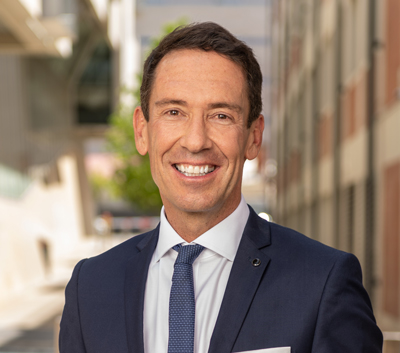
Internationally renowned marketing scientist Professor Byron Sharp has been honoured with a Lifetime Achievement Award by the European Marketing Confederation (EMC), one of Europe’s largest and most influential marketing membership organisations.
The award was presented as part of International Marketing Day, recognised annually on 27 May by the EMC to celebrate the vital role marketing plays in both business and society.
Each year, the Lifetime Achievement Award for Marketing recognises individuals who have made significant, long-lasting contributions to the marketing field.
The selection process is conducted in two stages. First, EMC member countries nominate exceptional candidates, with the final decision made through a vote by national marketing organisations.
Professor Sharp, Director of UniSA’s Ehrenberg-Bass Institute for Marketing Science, was recognised for his outstanding contributions to the marketing profession, particularly his groundbreaking research and book How Brands Grow, which has transformed marketing practices and inspired professionals around the world.
“Like almost everyone in marketing, I’ve read How Brands Grow – a book that has profoundly influenced the way we think about brand growth,” says Chief Operations Officer of the European Marketing Confederation, Martin Huisman. “In my time as NIMA chair, I also had the pleasure of inviting Byron Sharp to speak in Amsterdam. Beyond the brilliance of his book, his presentation was equally compelling. A true professional and thought leader – this award is more than deserved.”
PhD student makes a big splash with his research
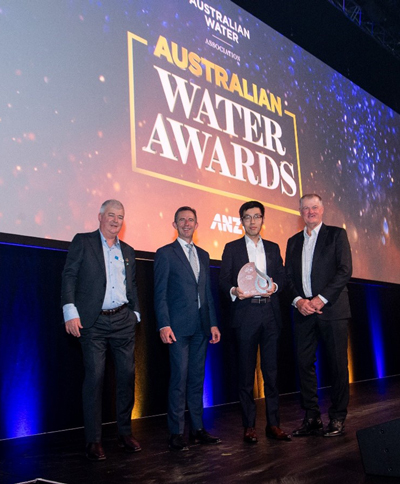 Weiwei Duan, pictured with AWA President Peter Dennis, former Senator Simon Birmingham and sponsor Tony Guidera at the national awards.
Weiwei Duan, pictured with AWA President Peter Dennis, former Senator Simon Birmingham and sponsor Tony Guidera at the national awards.UniSA PhD candidate Weiwei Duan has made history, taking out the 2025 Australian Water Association’s Student Water Prize – the first UniSA student to receive this national honour in 60 years.
Duan’s award-winning research involves using sludge – a byproduct of the water purification process – as a key ingredient in a new, eco-friendly sustainable material that can replace traditional concrete in sewer pipes, which is prone to cracking and corrosion.
His research solves two issues: finding a productive use for water treatment residue and creating a more durable and sustainable alternative to concrete.
By combining sludge with another industrial byproduct (slag), Duan has helped to create an alkaline-activated material that offers a low-carbon, acid and corrosion-resistant alternative to traditional cement.
“The material is mechanically stronger than concrete, more durable, and much better at resisting acid and microbial corrosion found in sewers,” he says. “It also reduces a common concrete problem called alkali-silica reaction, which can cause cracking over time, shortening its lifespan.”
Duan is supervised by UniSA professors Yan Zhuge, Chris Chow, Erica Donner, Dr Yue Liu, and Dr Alex Keegan from SA Water.
King’s Birthday Honours for UniSA community
Alumni, honorary doctorate recipients and other members of the UniSA community are among those recognised in this year’s King’s Birthday Honours List.
Those receiving honours included UniSA honorary doctorate recipient Phillip Adams, who was made a Companion of the Order of Australia (AC) for service to broadcast media, journalism, the arts, cultural leadership and the community.
Fellow UniSA honorary doctorate recipient Wendy McCarthy was made an AC for service to children and youth, health, arts, business, the community and women’s leadership.
UniSA alumnus Emeritus Professor Roger Byard was also made an AC for his service to medicine, forensic pathology, tertiary education as an academic and researcher and to the community.
A full list of the University’s alumni community who were acknowledged in the King’s Birthday Honours is available on the UniSA alumni network page.
Other recent award winners and grant recipients
Other recent award winners and grant recipients from UniSA include:
- Professor Peter Hoffmann has been awarded a 2025 ACGR Award for Excellence in Graduate Research by the Australian Council of Graduate Research (ACGR). Prof Hoffmann, who is the Lloyd Sansom Chair in Biomaterials Engineering & Nanomedicine at UniSA, received the award for Excellence in Industry Engagement for pioneering collaborative PhD programs with major partners such as CSL Limited and Coopers Brewery. His approach embeds Higher Degree Research (HDR) candidates in real-world research settings, creating clear academic and employment pathway. The awards showcase best practice in HDR across supervision, leadership, industry engagement and candidate support.
ANNOUNCEMENTS
UniSA role in $500m research centres to advance Australia’s manufacturing sector
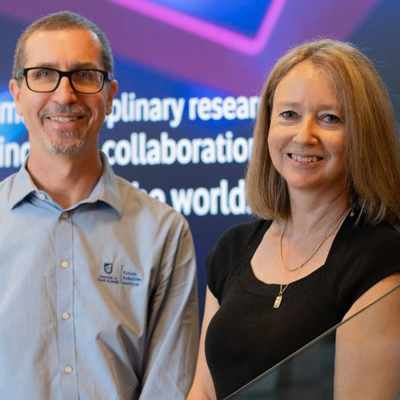 Future Industries Institute researchers Professor Colin Hall and Professor Allison Cowin.
Future Industries Institute researchers Professor Colin Hall and Professor Allison Cowin.UniSA researchers are the big winners in a Federal Government announcement of two new industry-led collaborative research centres designed to strengthen Australia’s manufacturing sector.
The Future Industries Institute will play a major role in both the Additive Manufacturing CRC and the SMART CRC, collectively awarded more than $500 million in funding from industry, research organisations and government.
FII Industry Professor Colin Hall is one of the key researchers in the newly established AMCRC, that involves 73 industry partners, 14 research organisations and five government departments, sharing in $57.5 million in government funding and $213 million in partner contributions.
He says that additive manufacturing – commonly known as 3D printing – is revolutionising the way that many industries work.
“Once limited to plastic prototype parts, 3D printing today includes metal, ceramic and composite materials that are on the cusp of full-scale adoption across Australia’s manufacturing sector,” Prof Hall says.
“Additive manufacturing offers significant advantages, boosting productivity, reducing waste and accelerating product development.”
Over the next seven years, the AMCRC will tackle some significant challenges hampering the advancement of 3D printing, so that processes can be optimised, new materials developed, and the workforce upskilled.
FII Professor Allison Cowin, an international leader in wound healing and regenerative medicine, will be a key researcher in the $238 million Solutions for Manufacturing Advanced Regenerative Therapies (SMART) CRC.
The SMART CRC involves 63 partners spanning government, industry, medical providers, universities and research institutes, all focused on helping Australian biotechnology and pharmaceutical companies bring a 10-year pipeline of regenerative therapy projects to market.
A $65 million commitment from the Federal Government will be boosted by an additional $173 million in partner contributions.
Prof Cowin, recognised as one of 10 of the best NHMRC researchers in 2025, will be joined on the SMART CRC Management team by Professor Joy Rathjen from SA Pathology, University of Adelaide Professor Simon Barry and former SA Chief Scientist Dr Leanna Read, who will chair its board.
“The SMART CRC will accelerate the Australian regenerative therapy industry,” Prof Cowin says. “It will catalyse, drive and co-ordinate a national effort, guiding industry growth in the cell and gene therapy sectors.
“Regenerative therapies aim to cure, rather than treat diseases. They replace, engineer and regenerate human cells, tissues and organs that will restore normal function in patients with diseases such as cancer, diabetes, wounds and blood disorders.”
APPOINTMENTS
Adelaide University appoints new Vice Chancellor
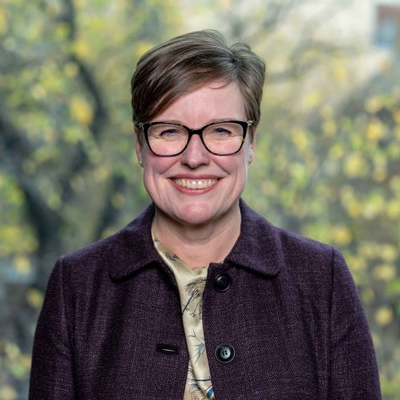 The new Adelaide University Vice Chancellor, Professor Nicola Phillips.
The new Adelaide University Vice Chancellor, Professor Nicola Phillips.Following a comprehensive global search, Australia’s new major university announces Professor Nicola Phillips as its new Vice Chancellor and President (Vice Chancellor) with effect from 12 January 2026.
The Adelaide University Transition Council has unanimously resolved to appoint Prof Nicola Phillips as the new Vice Chancellor of Adelaide University following exceptional global interest and a high-quality candidate field.
Chancellor of the Adelaide University Transition Council (Transition Council), Pauline Carr, says that finding the right person to lead the institution through its formative years was imperative.
“We are delighted to announce Prof Phillips as the new Vice Chancellor of Adelaide University as we boldly take our next steps as Australia’s new comprehensive university for the future,” Carr says.
Prof Phillips joins Adelaide University from the University of Melbourne, where she is currently the Provost and has served as both Acting and Interim Vice Chancellor. With some 30 years of experience in the higher education sector across Australia and the United Kingdom, Prof Phillips has cultivated a deep understanding of the sector and brings a local and global perspective to the position.
“Throughout her career, Prof Phillips has been a formidable force, guiding significant step-changes across contemporary academic delivery, student access and equity, Aboriginal knowledges, online education, and cultural inclusivity – with strong alignment to Adelaide University’s strategic direction as a differentiated member of Australia’s Group of Eight,” Carr says.
Read more in the media release about the appointment.
Other Stories
- Flat out Fabulous: Barbie puts her best foot forward over the years
- Back into the closet: Is aged care failing LGBTI+ people?
- UniSA film and TV tutor releases debut feature film nationally
- ‘They are like my children’: research reveals 4 types of indoor plant owners. Which one are you?
- From the Vice Chancellor: Some things change, some stay the same
- Achievements and Announcements
- Beanies for babies: UniSA students contribute to Papua New Guinea midwifery project
- Seven honorary awards conferred in April
- Take a trip through time, drawers and hard drives to preserve UniSA’s past
- In Pictures: UniSA April graduations
- The latest books from UniSA researchers June 2025


